As anyone who has read the posts about My Life knows, I’ve been a BIG fan of the space program for just about my entire life. In my very first post in the My Heroes volume of this blog, Inspiration, I included a video of the opening to Star Trek: Enterprise. You know, the one with all the wonderful sailing and NASA images. Even then, I was planning to write this one, not only as a tribute to the 40th anniversary of the 1st moon landing, but as a tribute to all of those who help make it possible.
But how does one pay proper tribute to all of the great men and women that have contributed to the fantastic successes of the U.S. space program? Somehow, a few photos and a video from the NASA archives just doesn’t do it justice. You know, I was too young to remember when the Soviet Union launched Sputnik, and I’m embarrassed to admit that I can barely recollect the assassination of JFK, but I remember his speech were he announced America’s mission to put a man on the moon! Even though my resources were limited, I read and watched everything I could find about rockets and space travel. For more about that, take a look at my Environmental Impact post.
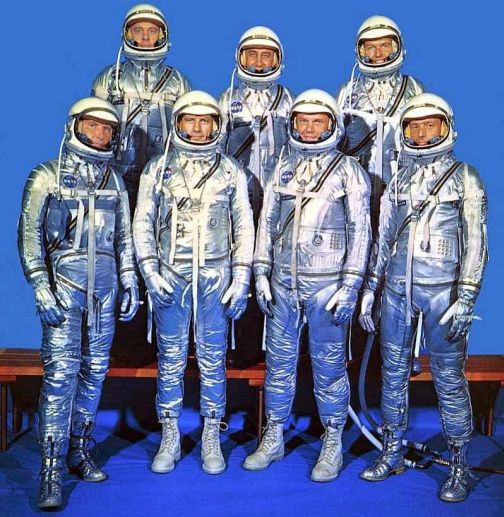
The original Mercury 7. From left to right, Walter M. Schirra, Jr., Alan B. Shepard, Jr., Donald K. 'Deke' Slayton, Virgil I. 'Gus' Grissom, John H. Glenn, Jr., L. Gordon Cooper, and M. Scott Carpenter. 'Deke' Slayton is the only one to never fly an actual mission.



The Redstone rocket was used for the first Mercury Missions. The Atlas rocket was used for most of the Mercury missions, including John Glenn’s historic flight to become the first American to orbit the earth. The Titan rocket was used throughout the Gemini program, where virtually every skill needed for the Apollo missions was perfected.
Tragically, the technology was not so perfect. The use of pure oxygen in the Apollo 1 Command Module proved to be a fatal flaw.
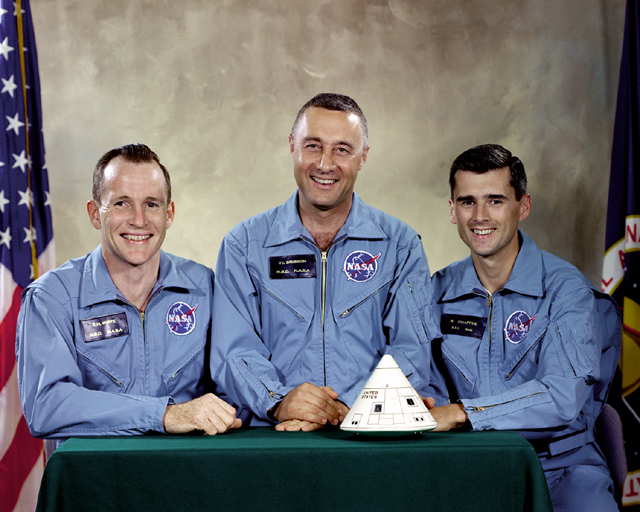
The Crew of Apollo 1. All three astronauts, Lt. Col. Virgil I. Grissom, a veteran of Mercury and Gemini missions; Lt. Col. Edward H. White, the astronaut who had performed the first United States extravehicular activity during the Gemini program; and Roger B. Chaffee, an astronaut preparing for his first space flight, died in a tragic accident while preparing for their mission.
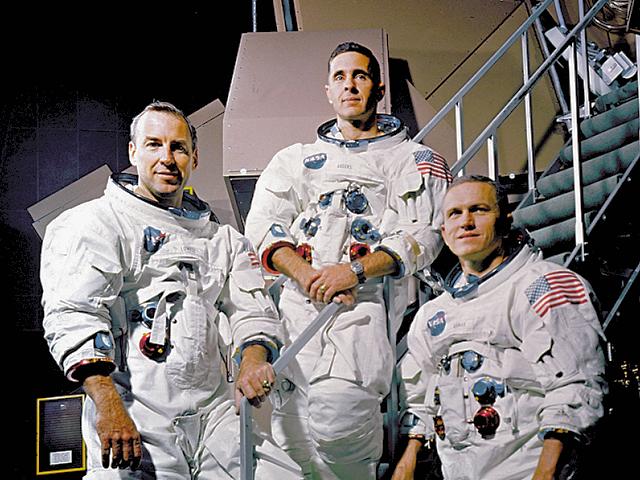
The Apollo 8 crew from left to right: Command Module pilot James A. Lovell, Lunar Module pilot William A. Anders, and Mission Commander Frank Borman. Apollo 8 was the first mission to take humans to the Moon and back. An important prelude to actually landing on the Moon was testing the flight trajectory and operations for getting there and back. Apollo 8 did this and acheived many other firsts including the first manned mission launched on the Saturn V, first manned launch from NASA's new Moonport, and first live TV coverage of the lunar surface.
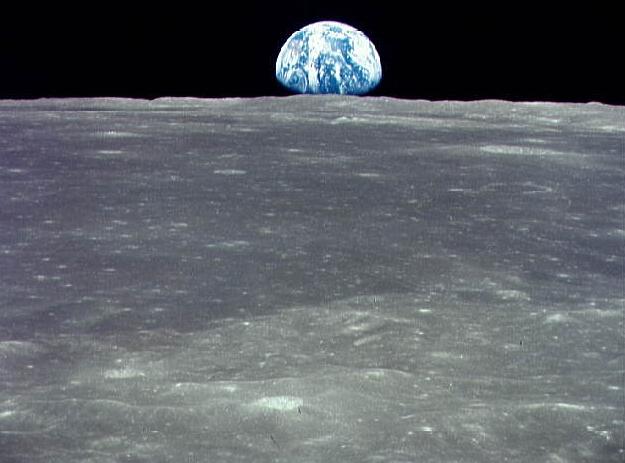
The crew of Apollo 8 were the first humans to see the Earth from deep space.
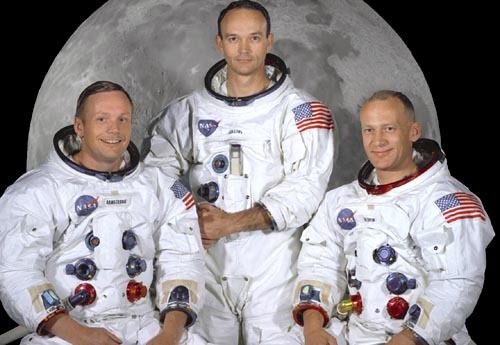
The Apollo 11 crew from left to right: Mission Commander Neil Armstrong, Command Module pilot Michael Collins, and Lunar Module pilot Edwin "Buzz" Aldrin.
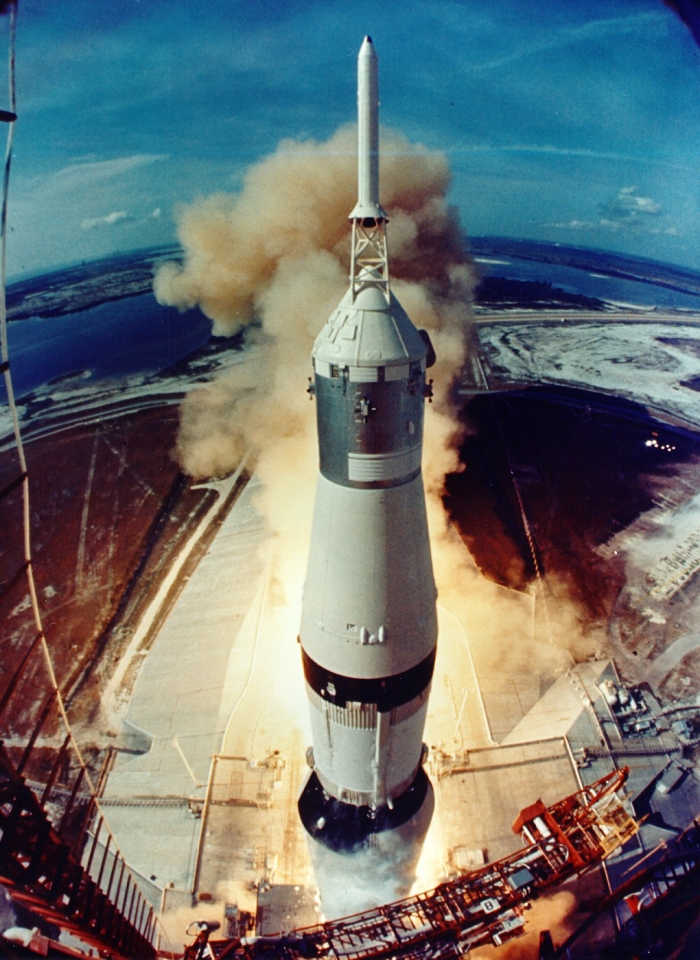
The Launch of the awesome Saturn V rocket carrying Apollo 11 to the moon on July 16, 1969 13:32:00 UTC
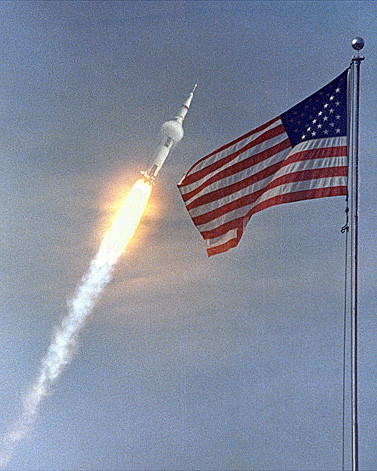
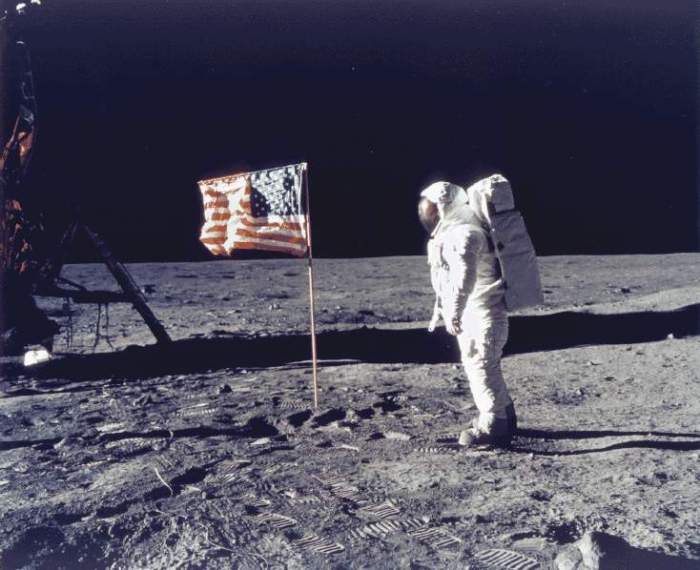

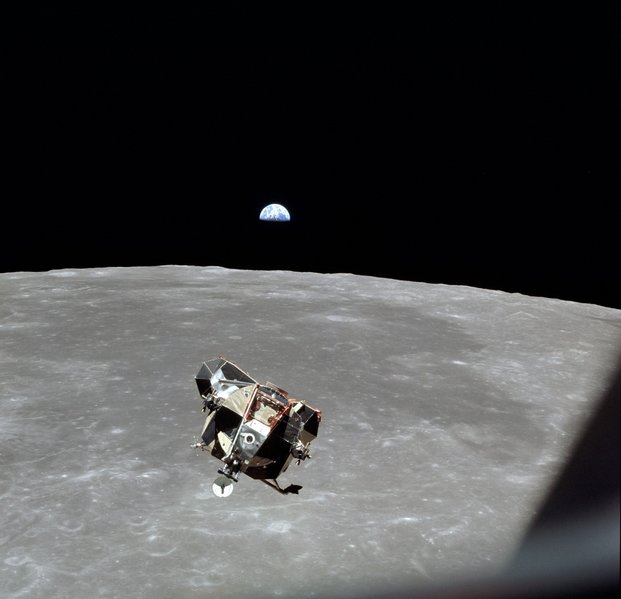
The Apollo 11 lunar module "Eagle" as it returned from the surface of the moon to dock with the command module "Columbia". Because of a computer overload problem, almost all of the fuel allocated for descent had been used on the way down. The ascent engine needed to get the astronauts off the moon had failed to ignite on 3 out of 6 tries with previous modules. It fired on this occasion, but only after Buzz Aldrin bypassed a broken firing fuse by jamming an ink pen into it.

Apollo 11 Returns Home on July 24, 1969 16:50:35 UTC
Once again, even on the heels of such fabulous success, space flight proved to be a very dangerous ambition.
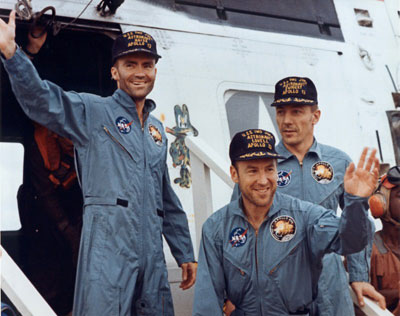
The Crew of Apollo 13, Fred Haise, Jim Lovell, and Jack Swigert, safely on Earth after a near disaster when oxygen tank 2 exploded 55 hours into the mission. Using the lunar module as a lifeboat, the three men were able to return safely to the Earth. Amazingly, this was Jim Lovell's second trip to the moon without being able to land.
I’ll bet even these guys were surprised at how quickly the gleaming success can be doused by political expediency.

The Crew of Apollo 17. Harrison ‘Jack’ Schmitt and Ronald B. Evans standing, and Eugene Cernan sitting. Apollo 17 was the final Apollo moon mission, the eleventh manned Apollo mission, the first night launch and the sixth and final lunar landing mission of the NASA Apollo program. Apollo 17 broke several records set by previous flights, including longest manned lunar landing flight, largest lunar sample return, longest total lunar surface extravehicular activities and longest time in lunar orbit.
So it was on to different things, and a great new story of success. Until nature reminded us once again of the risks we dared.
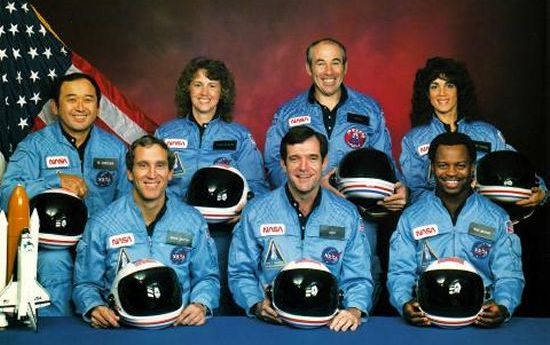
The crew of Challenger mission STS-51-L, El Onizuka, Mike Smith, Christa McAuliffe, Dick Scobee, Greg Jarvis, Ron McNair, and Judy Resnik, died tragically in the explosion of their spacecraft during the launch of STS-51-L from the Kennedy Space Center about 11:40 a.m., EST, on January 28, 1986. The explosion occurred 73 seconds into the flight as a result of a leak in one of two Solid Rocket Boosters that ignited the main liquid fuel tank.
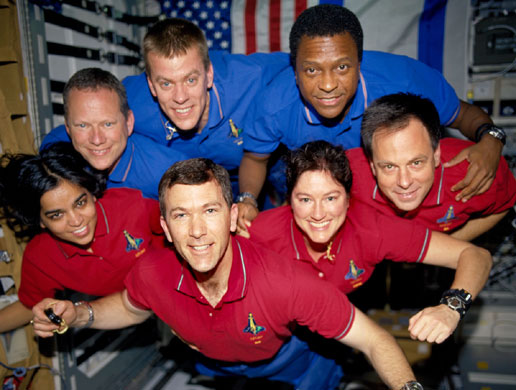
The crew of Columbia mission STS-107, clockwise from top left, Mission Specialist David Brown, Pilot William McCool, Payload Commander Michael Anderson, Payload Specialist Ilan Ramon, Mission Specialist Laurel Clark, Commander Rick Husband, and Mission Specialist Kalpana Chawla. Columbia broke apart about 12 miles (20 km) over Texas as it headed for landing at the Kennedy Space Center. The cause of the accident was traced to a hole in one of the shuttle's wings, which was hit by a piece of falling foam insulation during launch 16 days earlier.
But all was certainly not lost. And even though the shuttle program is nearing the end of it’s life, cut short by cost overruns and the fear of further disasters, it still towers as one our greatest achievements.
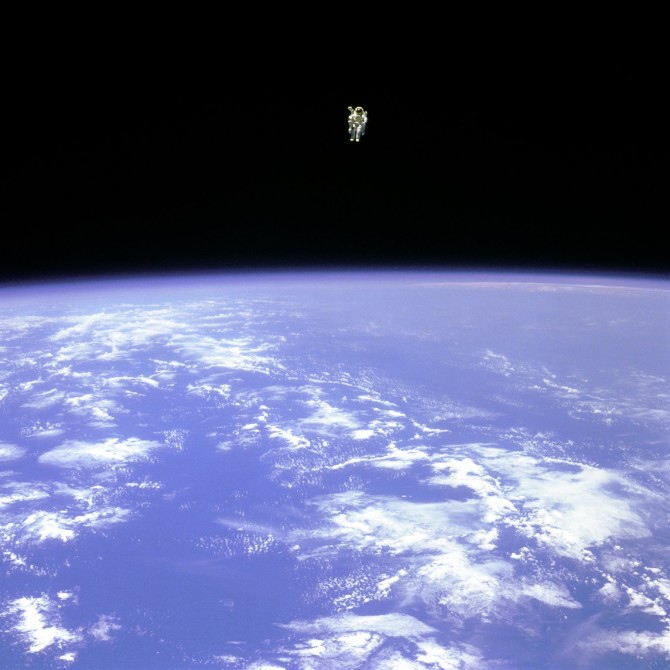
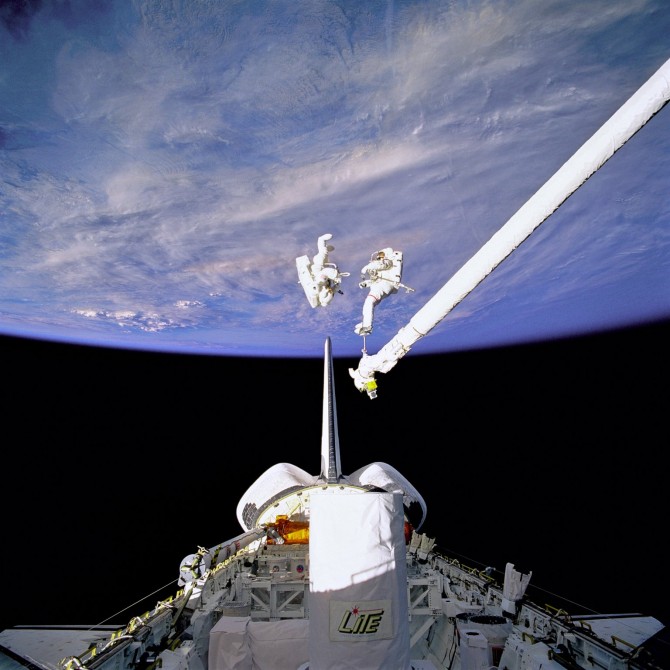
Now what kind of modern blogger would I be if I didn’t include some great videos to complete the story?
I’m sure that I’ve left out a lot of things, but the weight of this thing has already slowed my old hunk-o-junk to a crawl. Suffice it to say that I’m a ‘space head’ to the core. I am disillusioned, however, that we haven’t been back to the moon in all these years. And the International Space Station certainly isn’t living up to expectations. I thought we’d have been to Mars by now!
But the definition of ‘space head’ includes being a hopeless dreamer as well, and my fondest wish is that we’ll someday realize that it’s just not wise to keep all our eggs in this one basket. After all, space is a dangerous place – even when your ship is as big as the Earth. Besides, conquering the unconquerable is in our nature. I also think it’s good for the soul.
Just as I was gathering up the final materials for this post, I received an e-mail inviting me to read an article about Buzz Aldrin’s long struggle with depression after being one of the first two men to walk on surface of the moon. Talk about irony! The e-mail was from MyDepressionConnection and the article is called Forty Years Back from the Moon. I found it to be … fascinating.
If you liked this post, you might also enjoy Rocket Man!, Alpha!, Why A Space Program?, Recent Asteroid Discoveries Prove Need For Robust Space Program, and my tribute to Carl Sagan. Please feel free to comment.
I want ice water.











This post leaves me breathless and speechless. Awesome, is the only word that keeps coming to mind. Thanks for putting all of that together.
LikeLike
Thanks a lot. It literally took me all day, not counting searching through all of those videos and photos, and then getting the captions correct…
But your comment – the first – has made it well worth the effort.
Thanks again.
LikeLike
Hey bats, I made a couple of changes, most notably the addition of a photo of the Lunar Module with some interesting facts in the caption. The other changes are mainly for the sake of my vanity…
LikeLike
yo dawggg this shittt is hottt. ;D
LikeLike
Thanks.
LikeLike
it sux
LikeLike
Sorry to disappoint you. I hope you find better elsewhere.
LikeLike
wow fantastic……..
LikeLike
Wonderful stuff – well done! The recent 40th anniversary of apollo 11 has reignited my childhood obsessions with the Moon and space travel in general. Just one thing (Columbo stylee!) – what’s the piano music you’ve used on the first ‘Apollo 11 on the sea of tranquillity’ video? My wife was listening in as I looked at the footage and thought I’d suddenly developed some sort of sophisticated musical taste!
LikeLike
Thanks you for the very nice comment. Sadly, I can’t name that wonderful music from the first video, although it’s hauntingly familiar. I guess that’s part of it’s appeal. I’d love to know the answer myself. 🙂
LikeLike
Great job man, I like it very much, tersely and easy to read
LikeLike
My thanks to you, my friend! I watched the video linked to your name: Awesome! I’ve wanted an excuse to have some Vangelis on my blog for a long time. I hope you don’t mind if I build a post around your video. 😀
LikeLike
You have your order wrong on the Apollo 11 crew order. It’s Armstrong, Collins and Aldrin Left to right, not Collins, Armstrong, Aldrin.
LikeLike
Pingback: 2010 In Review | I Want Ice Water
Pingback: Why A Space Program? | I Want Ice Water
superb post… so want and need the space program back,
LikeLike
Pingback: Guestblog: I want Icewater « Erotixx
This is a fine posting Mak and brings back many memories
as I read and browse your excellent choices of pictures, the
Space Programme was, and still is so very important but it
seems like the world has moved on, not acknowledging the
many breakthroughs and exceptional bravery of those first
Astronauts, and the Moon landing that truly rocked the world
giving way to fantasies and adventure for so many children
and adults alike.
Space, the final frontier indeed, not a fiction but harsh reality…
Have a great evening Mak 🙂
Androgoth
LikeLike
Thanks you so much Andros! I am very proud of this one. It was an honor to put together! 😀
If you liked this one, then you should check out my The Grand Finale! post! 😀
LikeLike
Yes I will call over later and
check that one out my friend 🙂
It is a very interesting subject 🙂
Androgoth
LikeLike
Thanks Andros. I’m looking forward to seeing what you think! 😀
LikeLike
Pingback: One Giant Loss – Neil Armstrong Dead At 82 | I Want Ice Water